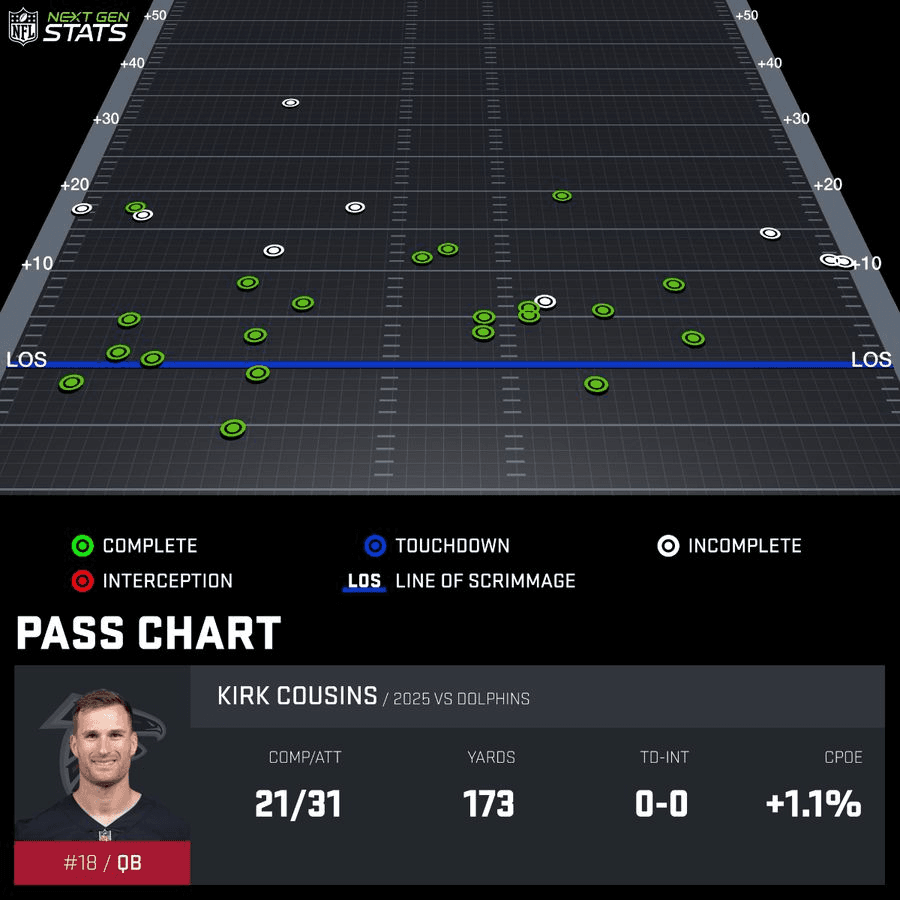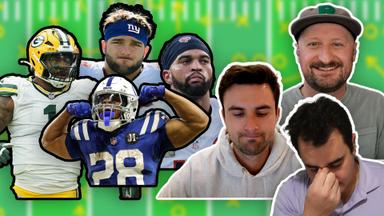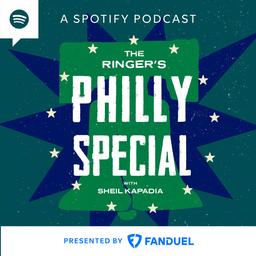Every week this NFL season, we will break down the highs and lows—and everything in between—from the most recent slate of pro football. This week, the slate was defined by blowouts, Jordan Love had a near-perfect fourth quarter to ruin Aaron Rodgers’s revenge bid, Sean Payton called a brilliant game to exploit the Cowboys’ defensive weaknesses, Jonathan Taylor is building an unlikely MVP case, the Jets finally got their first win, and more. Welcome to Winners and Losers.
Winner: Jordan Love
On Sunday night, Love confirmed what the Packers believed three years ago when they moved on from Aaron Rodgers: that Rodgers’s former mentee had passed the veteran by. If that wasn’t apparent in the very first year of the Love era in Green Bay, when he led the Packers to a playoff win over Dallas, it definitely is now. On Sunday, Love threw for 360 yards and three touchdowns in a win over Rodgers’s Steelers that kept the Packers atop the NFC standings at 5-1-1. And if there were any Packers fans who still weren’t over Rodgers and hadn’t fully accepted Love as the team’s franchise quarterback, I’m not sure there was anything more they needed to see.
Love put his entire skill set on display against Pittsburgh. He threw with good timing, averaging just under 2.5 seconds per attempt. He wasn’t sacked, despite being pressured on nearly a fourth of his dropbacks. Love faced plenty of pressure but often beat it with his signature fadeaway. And Love was accurate, completing 20 passes in a row at one point.
There were a handful of layups mixed in there, but Love kept the streak going with some truly outrageous throws. This cross-body heave to Christian Watson on third down had no business being completed.
Packers receivers made some unreal catches and helped Love by getting open all night. Pittsburgh tried to play man coverage against Green Bay’s deep group of pass catchers but found little success. Tight end Tucker Kraft looked like a Rob Gronkowski–Travis Kelce hybrid in the open field, catching all seven of his targets against man coverage for 143 yards and a pair of touchdowns, per Next Gen Stats. Watson, in his first game back since suffering an ACL tear in 2024, caught four passes for 85 yards, with 52 of those yards coming against man coverage. In all, Love averaged over 13 yards per attempt and threw all three of his touchdowns against Pittsburgh’s man coverage.
This is a continuation of a positive trend for Love, who’s been dicing up man coverage after struggling against it in 2024. He’s made significant jumps in EPA per dropback, yards per dropback, and success rate.
Jordan Love Against Man Coverage, 2024 vs. 2025 (TruMedia)
Love is scrambling more often when he sees man coverage, which makes sense. Coverage defenders are chasing their matchups, and because their backs are turned, there’s more room for Love to scramble. Last season, Love hardly took advantage, scrambling on just 1.6 percent of his dropbacks against man. In 2025, that’s up to 8.3 percent, per TruMedia. He’s finally putting his mobility to use when Packers receivers aren’t getting open, and it’s unlocked another level for the passing game.
Love is playing at a level that Rodgers, in his 40s and two years removed from a major Achilles tendon injury, can no longer reach. As we saw on Sunday in the loss to the Packers, the Steelers quarterback can still deliver beautiful passes when he has time and space in the pocket, but he’s pretty much useless when put under any pressure. Rodgers averaged 0.4 yards on six pressured dropbacks, per TruMedia. That would be impressive if it were his EPA average, but that was –0.43 per dropback. (And that’s actually an improvement on his full-season average of –0.50 EPA per dropback, which ranks 28th in the NFL.)
As Rodgers has learned since losing his mobility a few years back, playing quarterback today is a lot harder when you can’t move or throw off-platform. It’s a problem the Packers haven’t been concerned with going back to the early 1990s, when Brett Favre took over as the starter. Rodgers could always throw on the move during his time in green and gold, and now Love has added that ability to his game.
Winner: Jonathan Taylor’s MVP Campaign
It’s time for our weekly check-in on the NFL’s most dominant offense. The Colts ran over the Titans, 38-14, on their way to a 7-1 start. I’ve already spent plenty of time talking about the resurgence of Daniel Jones and the ingenious play calling of Shane Steichen this season, so it’s probably past time for me to finally give the team’s best player his flowers. That’s running back Jonathan Taylor, who was already the betting favorite to win Offensive Player of the Year before racking up 153 yards and two touchdowns on only 12 carries against Tennessee. I know we don’t give the MVP award to running backs anymore, but if we weren’t so quarterback-obsessed, Taylor would be the leader in the race for the league’s biggest individual award.
Taylor leads the league in yards from scrimmage (1,056) and total touchdowns (14), which puts him on pace for a 2,244-yard, 28-touchdown season. Adrian Peterson had 2,314 scrimmage yards and 13 total touchdowns during his MVP-winning season in 2012, which was the last time we saw a non-quarterback win the award.
Look, I get why a quarterback always wins MVP and why running backs no longer do: The success of a team’s run game is typically more influenced by the performance of the offensive line and play calling. But we have advanced metrics that can account for the degree of difficulty a runner faces, and those stats say Taylor is having an exceptional season. He leads the NFL with 366 rushing yards after missed tackles, and he’s forcing a missed tackle on 34 percent of his rush attempts. And he’s currently ranked second with 203 rushing yards over expected, per Next Gen Stats. Against the Titans on Sunday, he averaged 8.4 yards after contact and generated 131 rushing yards after forcing missed tackles.
The Colts’ offensive line may be blocking its collective ass off, but how many running backs are deleting this defender’s tackling angle and taking this run to the house?
How many backs are making this play?
Or this one?
If we gave Josh Allen a “here, damn” MVP award last year, can’t we do the same for a running back? This would be the season to do it because there isn’t a truly dominant quarterback. Lamar Jackson and Joe Burrow are hurt, the Bills have Allen playing like a game manager, and Patrick Mahomes isn’t putting up top-five passing stats (yet). And while I love Drake Maye’s game, he’ll have plenty of time to win MVP over the next decade.
Even after Taylor’s historic start to the season, there are still seven players with better odds to win the award, including his teammate Jones. Taylor is just ahead of Jalen Hurts, who’s thrown for at least 300 yards only once all season. Taylor has no margin for error in the MVP race. He’ll have to keep up this ridiculous pace just to keep his name in the conversation. He may have to improve on his current pace—and get over 2,000 rushing yards—to actually win it. Based on his performance through two months, I wouldn’t rule that out completely.
Loser: Sean Payton’s Impulse Control
Just when you think Payton might have lost his fastball as a play caller, the Broncos coach goes and pitches a gem. After a week of hearing questions about the offense’s early-game struggles, Payton had Denver firing early in a 44-22 win over the Cowboys. Bo Nix threw four touchdown passes and finally found some downfield accuracy after a shaky start to the game and an opening-drive interception. Running backs J.K. Dobbins and RJ Harvey combined for 157 yards on the ground, which helped keep Nix out of obvious passing situations. Nix took just six of his 29 dropbacks on third down—only Tua Tagovailoa and Daniel Jones had fewer in Week 8, per TruMedia. It was a low-stress game for the Broncos quarterback against a hapless Dallas defense, thanks to Payton and the run game.
“We wanted to keep them in last,” Payton coldly said of the Cowboys’ last-ranked defense after the win, continuing his string of spicy press conferences after pissing off Russell Wilson last Sunday. Whether or not it was meant as a sign of disrespect, Payton insinuated that he built his game plan around the Cowboys defense being both bad and injured—and Payton showed little remorse for doing so. He set up mismatches for Nix to attack through the air, including one against cornerback Trikweze Bridges, a college teammate of both Nix and Denver receiver Troy Franklin, in what had to feel like a real-life re-creation of the crying Wesley Snipes meme for Denver’s Oregon alums.
Nix targeted Bridges 13 times throughout the game and burned him for 102 yards, two touchdowns, and five first downs, per Pro Football Focus. A recurring theme was a Broncos receiver running past Bridges, who looked like he was playing in quicksand. Rookie Pat Bryant ran right past him for his first career touchdown.
Courtland Sutton did the same for a big gain in the fourth quarter.
Denver’s offensive line also won its matchup in the trenches. Despite Jerry Jones’s preseason hopes, swapping out Micah Parsons for Kenny Clark has not fixed the Cowboys’ run defense. The Broncos got whatever they wanted on the ground on Sunday. Their ballcarriers averaged 1.3 yards before contact, a sign the offensive line was doing its job, and 5.1 yards after contact, showing how poorly Dallas tackled.
“Offensively, I felt like we did a great job with the line of scrimmage, so our run numbers, pass numbers, all of it was kind of lopsided,” Payton said of Denver’s dominant day. It was the second consecutive week that the Broncos have been able to run the ball efficiently, which makes things easier for Nix. We’ve seen that in stretches throughout the season, but Sunday’s performance was a full 60-minute production and a show of how much potential Payton’s offense carries when operating as designed. The operation has run smoothly the last five quarters against shoddy Cowboys and Giants defenses. Next week, the Broncos offense will attempt to do it against an elite Texans defense. If Payton can pull this off against them, he’ll have earned the right to talk as much shit as he’d like.
Winner: Tush Push Discourse
The game wasn’t all that interesting from a competitive standpoint, but there was a lot going on in the Eagles’ 38-20 win over the Giants. New York’s rookie running back, Cam Skattebo, was carted off after suffering a gruesome ankle injury that you should avoid watching at all costs. The Giants also lost one of their few healthy cornerbacks when Cor’Dale Flott caught a stray punch from his own teammate and was ruled out with a concussion. And the Giants took a metaphorical blow to the gut when the refs blew an early whistle and wiped out what should have been a fumble on an Eagles tush push.
Kayvon Thibodeaux ripped the ball out of Jalen Hurts’s hands as the Eagles quarterback reached it out beyond the first-down marker. Though you don’t hear a whistle until a few seconds after possession changed hands, the refs had apparently decided that Hurts’s forward progress had been stopped (it hadn’t) and the play was over before the fumble (it wasn’t). Giants coach Brian Daboll was able to eventually challenge the play after the officials initially denied his request. Daboll lost the challenge, the Eagles kept the ball, and Saquon Barkley found the end zone a play later.
Thibodeaux astutely called the ruling “some bullshit” after the game, which is a fitting way to describe the overall performance of the referee crew led by Brad Rogers. The refs blew an errant whistle after the snap on a missed field goal attempt by Philadelphia’s Jake Elliott. By rule, the down should have been replayed, but it was not.
And the Eagles were on the wrong end of a questionable fumble ruling when this Jaxson Dart fumble was overturned.
Most of the bad refereeing went against the Giants, though. There were missed false starts and questionable pass interference calls on both sides of the ball, including a soft offensive pass interference call that wiped out a long Darius Slayton touchdown on fourth-and-11.
That call sent Daboll into a fit of rage on the sideline and turned him a shade of red that matched the accents on the Giants uniforms.
To his credit, after the game, Daboll didn’t blame the result on the refs and admitted his team was outplayed in all three phases. It’s true: New York didn’t play well enough to win—even if the officiating had been a bit more equitable. The Eagles dominated in the run game; Barkley went off for 150 yards before injuring his hamstring on his 14th carry of the game. Barkley opened the scoring with a 65-yard touchdown on the second play of the day.
You’ll notice the Eagles had Hurts lined up under center on that play. First-year offensive coordinator Kevin Patullo has been doing more of that in recent weeks, and it’s helped set up Hurts for success in the passing game. Philadelphia has mostly operated out of shotgun throughout the Nick Sirianni era, so this could be a new wrinkle that gives the offense a much-needed boost down the stretch of the season.
The Eagles defense also enjoyed a bounce-back performance on Sunday. Defensive coordinator Vic Fangio dared Dart to go through his progressions in the pocket. The rookie looked uncomfortable doing that and dropped his eyes from downfield to look for exit lanes on a number of dropbacks. Fangio’s coverages and pressures had Dart seemingly doing TikTok dances in the pocket on his way to taking five sacks.
It’s too early to say definitively that Philadelphia’s pass rush and running game are back, but in Sunday’s game, both performed in a way that we haven’t seen since the Super Bowl run last season. Unfortunately, thanks to the refereeing crew that was off its game all afternoon, that may be overshadowed by yet another round of tush push discourse. If the refs’ inability to properly officiate the play isn’t enough to get it banned next offseason, the prospect of never having to debate the play again should be enough to secure the votes.
Losers: Washed-Up Backups
All right, I’ll admit it. I was a little excited to see whether Kirk Cousins or Andy Dalton had anything left when the 30-something backups were tapped to start for the Falcons and Panthers, respectively, in Week 8, a little more than a week before the trade deadline. It took about a quarter of play from both quarterbacks for that excitement to turn into existential boredom. Cousins and Dalton both looked like guys who didn’t want to be playing.
Let’s start with Cousins, who drew some interest on the offseason trade market and may have drummed up more over the next week had he lit up a bad Dolphins defense on Sunday. I guess we’ll never know. If this was Cousins’s last stand, he went out sad, throwing for just 173 yards on 31 attempts in a 34-10 loss to a broken Miami team. Despite being behind for most of the game, Cousins attempted just one pass over 20 air yards, and that was incomplete.

The 37-year-old passer has little mobility left and rarely tries to use it. He looked like he was just trying to survive Sunday’s game rather than trying to win it, knowing that the direct deposit would still hit in a few days either way. The prospect of Cousins getting traded to a QB-needy team was already a long shot before Sunday’s stinker—he’s due a $10 million roster bonus next offseason that will scare off teams—and now it feels like a nonstarter after seeing his work against the Dolphins. If Cousins is going to launch the final chapter of his career out of Atlanta, he may have to wait until 2026 for his chance.
And yet, Dalton’s Sunday was even worse. His Panthers lost 40-9 to the Bills, and Dalton may have been the worst player on the field. He turned the ball over twice and took an inexcusable sack that cost Carolina a chance at a field goal before the half.
That was one of seven sacks taken by Dalton, who was playing behind a line that lost three starters throughout the day. Brady Christensen was carted off with an Achilles injury, Taylor Moton was ruled out with a knee injury, and Cade Mays didn’t return from a second-quarter ankle injury. Still, not all of Carolina’s issues in pass protection could be pinned on the offensive line. Dalton contributed to the mess with his indecision and inability to escape Buffalo’s rush. Avoiding sacks had been an underrated aspect of Dalton’s game during his prime years in Cincinnati, but his ability to do so now seems diminished.
Of course, Dalton isn’t solely to blame for the blowout loss. He didn’t get any help from his defense, which allowed Buffalo running back James Cook to rush for 216 yards and two touchdowns on 19 carries. But Dalton’s early mistakes put Buffalo’s offense in a positive game script, and Carolina’s defense was unable to pull the Bills out of it.
Sundays can have a way of reminding anyone in their late 30s that they don’t have it like they used to. For Cousins and Dalton, their wake-up call wasn’t a debilitating hangover—they just played like they had one—but rather a punishing and ineffective day on the field.
Winner: Breece Hall
Joe Flacco nearly got one back for the old quarterback gang, but a predictable defensive implosion by the Bengals wasted the 40-year-old quarterback’s effort. The Jets erased Cincinnati’s 31-16 lead in the fourth quarter and gave Aaron Glenn his first win as head coach. It was a Sunday of redemption for both Glenn and his quarterback, Justin Fields, whom team owner Woody Johnson publicly blamed for the team’s 0-7 record earlier in the week—but I’m hesitant to give either of them too much credit for New York’s win. Glenn, a defensive-minded head coach, watched his defense give up 38 points to Flacco. Fields had a solid day no matter how you spin it, but the comeback was mostly sparked by New York’s effective run game. Even with the Jets trailing by two scores for most of the second half, they still maintained a near-50/50 split in run and pass rates. You don’t often see an offense stick with its run game after falling behind by multiple scores, but when New York got desperate, the ball remained in Breece Hall’s hands—even on the game-winning touchdown pass, which came on a trick play.
Cue the obligatory “Breece Hall might be the best quarterback on the roster” jokes. He was certainly the best player on the field in Cincinnati. When he wasn’t throwing touchdowns, Hall was running for 133 yards and two touchdowns on just 18 carries. Per TruMedia, 112 of those yards came in the second half, when Hall averaged 0.92 EPA per rush attempt with a success rate of 80 percent.
Fields was an efficient passer during the comeback but completed just one pass that traveled more than 5 air yards. If a receiver didn’t pop open immediately, Fields either threw the ball away or looked to scramble. A few of his short passes turned into longer gains after the catch thanks to a generous Bengals defense.
As Glenn pointed out during his postgame news conference, Fields has been unfairly blamed for all of the issues on offense—even by the team owner—so maybe Fields has earned an outsize share of the credit for hanging in there on Sunday. And Glenn also deserves credit for tightening up his defense in the final two quarters and making the correct decision to go for two after a touchdown that cut Cincinnati's lead to eight in the fourth quarter, which allowed New York to win the game in regulation. But Hall was the star, and he got just enough support from his coach and quarterback to win the game.
Winner: Baltimore’s Playoff Hopes
With Cincinnati blowing its game, Cleveland getting blown out (despite a Tungsten Arm O’Doyle–like, five-sack outing from Myles Garrett), and Pittsburgh losing in prime time, Baltimore was a clear winner this week. It pulled within two games of the AFC North lead and will face the Steelers and Bengals four times total in the remainder of the season.
But the Ravens’ status as winners is pending after the team erroneously listed quarterback Lamar Jackson as a full participant at Friday’s practice. Jackson did take all of the scout team reps during practice, but he should have been designated as “limited” according to the league’s injury reporting guidelines. On Saturday, Baltimore updated Jackson’s Friday practice designation from “full” to “limited” and ruled him out for the game against Chicago. Head coach John Harbaugh’s explanation for the mix-up was essentially “We made an oopsie.” According to Pro Football Talk, the Ravens could be fined or stripped of a draft pick if the league office doesn’t accept that explanation. The strict injury reporting rules are set up to curb shady gambling activity—which is a growing problem throughout the sports world—but that erroneous injury report may have provided Baltimore with a competitive advantage if Chicago saw Jackson as a full participant and prepared to play against a two-time MVP rather than Tyler Huntley.
It turns out that the Bears defense didn’t look prepared for either quarterback. Huntley wasn’t asked to do too much in the 30-16 win in Baltimore. He logged just 25 dropbacks but averaged 8.5 yards on those plays and didn’t turn the ball over. Huntley also did a solid Lamar impression in the run game, adding 53 yards on five designed carries. The Ravens’ run game powered the win. Derrick Henry ran for 71 yards on 21 attempts but found the end zone twice, while Keaton Mitchell ran for 43 yards on four attempts off the bench.
This seems like a missed opportunity for the Bears, who have to be feeling some déjà vu. While this wasn’t nearly as dramatic as last year’s loss to Washington on a Hail Mary, Chicago once again blew a winnable Week 8 game and a chance to start the season 5-2. Both losses even took place in Maryland. That devastating loss to the Commanders sparked a losing streak that stretched to the final week of the season. Another Bears losing streak seems unlikely, with games against the Bengals, Giants, and Vikings up next on the schedule, but the vibes would have been much better if Chicago were heading into that stretch at 5-2 rather than 4-3.
And Sunday’s game felt like a setback for Chicago quarterback Caleb Williams, who had gotten off to a solid start to the season under first-year head coach Ben Johnson. Williams was mostly fine for the first three quarters, but he threw an interception early in the fourth quarter that set Baltimore up for a short touchdown drive.
Williams called that pass a “good read,” and while I’m inclined to agree with that analysis—he had Rome Odunze on a crossing route against man coverage—he didn’t need to publicly say that about a throw that ultimately lost Chicago the game. Later, Williams missed a chance to pad his stats when he sprayed a pass to an open DJ Moore on fourth-and-goal with under a minute remaining. Williams made the throw harder than it had to be. Rather than an over-the-top delivery to get the ball past the defensive line, he went with a sidearm technique that caused him to be high and wide on the throw. The Bears would have lost even if Williams had hit the throw, but it’s another bad look for a quarterback who’s been struggling with his accuracy since entering the league in 2024.
A playoff run is starting to feel like a long shot for a 4-3 Bears team with a porous defense, an inconsistent quarterback, and an unreliable run game. The opposite feels true for Baltimore. Even if the Ravens are 2-5, first place in the division is within reach, the defense is improving, the running game is showing signs of life, and Jackson should be a full participant at practice this week. For real this time.






